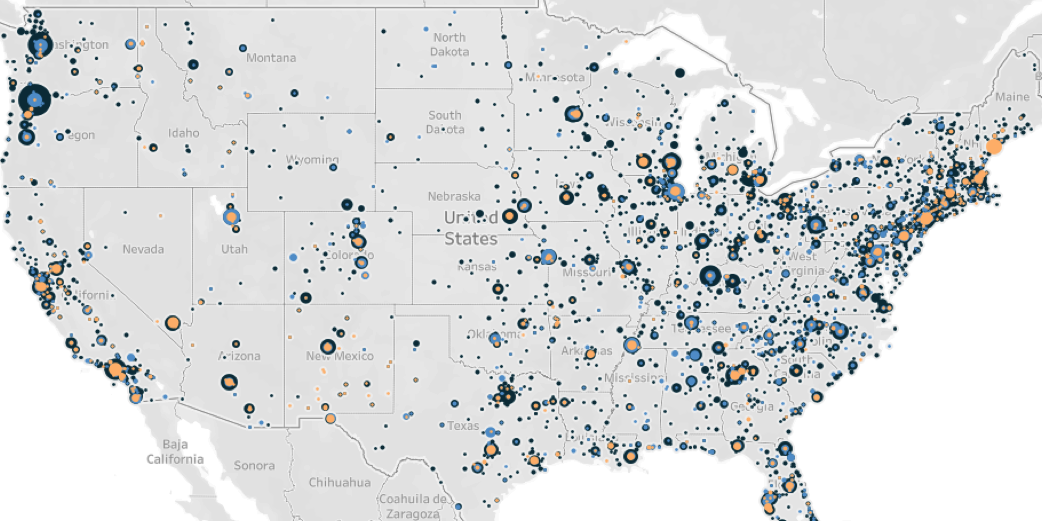31 August 2020: Nearly 11,000 demonstration, political violence, and strategic development events are recorded across America since the end of May, according to new US Crisis Monitor data gathered by ACLED. With supplemental data collection extending coverage back to the week of George Floyd’s killing, the dataset is now expanded to encompass the latest phase of the Black Lives Matter movement, growing unrest related to the COVID-19 pandemic, and violent political polarization ahead of the November general election.
The full dataset and crisis mapping tool are updated weekly and freely available for public use.
Between 24 May and 22 August, ACLED records more than 10,600 demonstration events across the country. Over 10,100 of these — or nearly 95% — involve peaceful protesters. Fewer than 570 — or approximately 5% — involve demonstrators engaging in violence.1See the US Crisis Monitor FAQs for more information about coding methodology and definitions.Well over 80% of all demonstrations reported during this period are connected to the Black Lives Matter movement or the COVID-19 pandemic.
The Black Lives Matter Movement
Nearly 73% of all demonstrations over this period are associated with the Black Lives Matter (BLM) movement.2This does not include other social justice demonstrations; the percentage would be even higher if social justice demonstrations that did not explicitly cite BLM as a driver were included.
- Since 26 May, the day after George Floyd was killed by police, ACLED records over 7,750 demonstrations associated with the BLM movement across more than 2,440 locations in all 50 states and DC
- States with the most events: California (819), New York (430), Florida (380), and Illinois (331)
- The vast majority of these events — more than 93% — involve non-violent demonstrators
- Approximately 9% of all demonstration events associated with the BLM movement — or nearly one in 10 events — have been met with intervention by police or other authorities
- Of these interventions, government personnel used force3Use of force spans from firing less-lethal weapons like tear gas and rubber bullets to beating demonstrators with batons. in more than half — at least 54%
- The majority of these events are reported in California, Oregon, and New York
- Authorities have also targeted journalists covering BLM demonstrations: ACLED records over 100 events of government violence against the media during demonstrations in 31 states and DC
- State intervention and use of force in demonstrations has increased relative to this time last year
- Non-state actors are becoming more aggressive and are increasingly engaging demonstrators
- Since Floyd’s killing, ACLED records over 100 events in which non-state actors intervened in demonstrations, including militia groups as well as individual attackers
- Individual perpetrators — sometimes linked to hate groups like the KKK — have launched dozens of car-ramming attacks targeting demonstrations around the country
- ACLED records activity by over 20 distinct militia groups across the US during this period, and non-state actors are engaging in demonstrations more often relative to this time last year
- Armed individuals are also becoming more common at demonstration events; in some cases they are present without engaging in the demonstrations — claiming to ‘keep the peace’ if not openly intimidate perceived ‘enemies’ — while in others they have engaged directly in demonstrations associated with the BLM movement. In total, over 50 such incidents are recorded since late May
- Since Floyd’s killing, ACLED records over 100 events in which non-state actors intervened in demonstrations, including militia groups as well as individual attackers
- The BLM movement has prompted a series of counter-protests, and many have turned violent
- Since May, over 360 counter-protests have been reported around the country
- Of these, more than 40 — nearly 12% — turned violent
- Counter-protests are growing and increasingly turning violent relative to this time last year
- Since May, over 360 counter-protests have been reported around the country
Globally, in the weeks following Floyd’s death, ACLED records at least 8,700 demonstrations in solidarity with the BLM movement across 74 countries.4ACLED does not yet cover Canada or Oceania. Data for Western Europe are not yet published, but will be released in the coming months. See ACLED’s full list of country and time period coverage here.
The COVID-19 Pandemic
The health crisis has also triggered a wave of unrest amid a devastating economic downturn and deep political divisions over an appropriate response.
- Since 24 May, over 1,000 demonstrations directly related to the pandemic have been reported across more than 500 locations in 47 states and DC
- States with the most events: California (156), New York (60), Florida (54), and Texas (54)
- More than 6% of these demonstrations have involved healthcare workers; over 32% have been connected to school reopenings; and close to 4% have been linked to the threat of mass evictions
- In early August, demonstrations connected to the pandemic surpassed demonstrations associated with the BLM movement for the first time all summer (for more, see ACLED’s COVID-19 Disorder Tracker)
Key findings from the new dataset are reviewed in this special report.

A US-based 501(c)(3) non-profit organization established in 2014, ACLED is the highest quality and most widely used real-time data and analysis source on political violence and demonstrations around the world.
If you would like to use data and analysis from the US Crisis Monitor, please review ACLED’s Terms of Use & Attribution Policy. For more information about ACLED methodology, please check the US coverage FAQs as well as the ACLED Resources library.
For interview requests and press inquiries, please contact: Sam Jones, Senior Communications Manager





